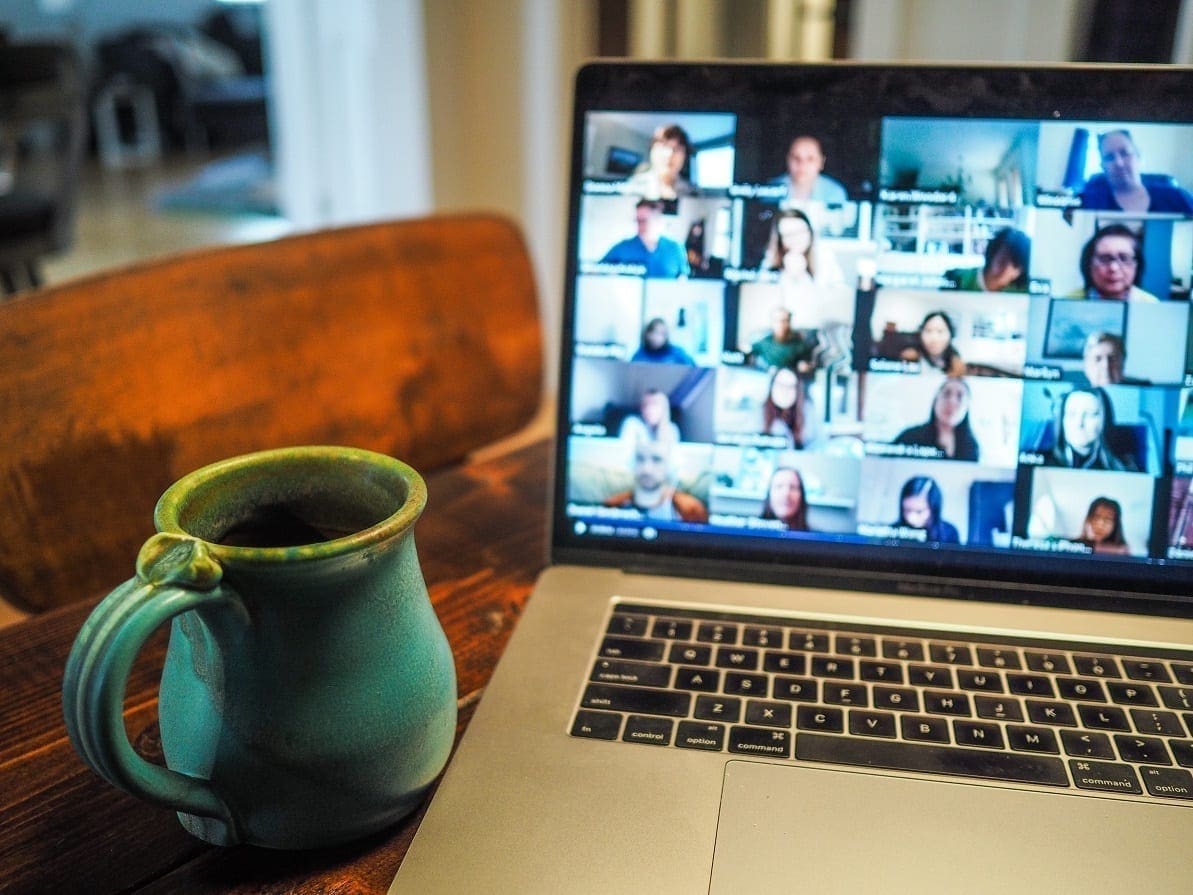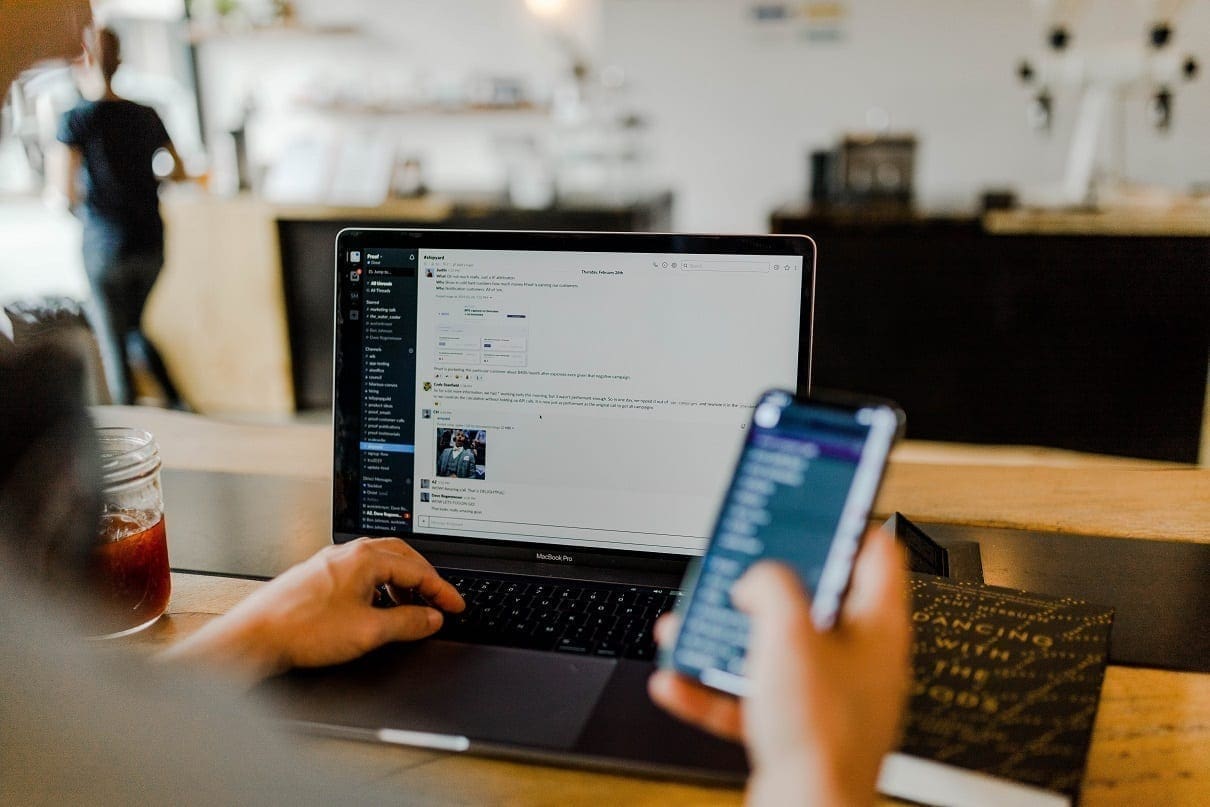This is Your Brain on Zoom: Friday, April 10, 2020. 6 p.m. I closed the Zoom app on my laptop. I took a deep breath and strode to the open window above the fire escape. It was a crisp 50 degrees, the trees were bare and passersby wore surgical masks. Something was wrong—and it wasn’t the pandemic looming outside my second-floor walkup.
I was staring down the barrel of my third espresso and like the cup, I was drained—empty. Half-awake. Devoid of motivation. My brain was an egg, cracked and frying crispy brown on a cast-iron skillet. Why do I feel this way? I’ve had long weeks before, but this was different. I couldn’t even muster the strength to order a gyro on GrubHub. It wasn’t that my publisher was on his twelfth virtual background of the week. Or even the sounds of my neighbor coughing in the hallway. It was something else.
There were more days like April 10. Sure, running a local publication like The Digest that relies on resources from the community during a global pandemic is grounds for feeling exhausted. But I have always loved my work; completing projects made me feel alive. A weekly conquest. Now, working from home was a pyrrhic victory.
In the weeks that followed, my entire life became April 10. A barrage of virtual meetings replaced my social life. Birthday parties. Happy hours. Dates. Everything. Everyone. In little boxes like the fucking Brady Bunch. Are my introverted habits finally being put to the test? Or is this simply the new normal? It all took a toll.
This is My Brain on Zoom.
I felt as used up as one of those blue masks kicked to the sidewalk. What’s worse, I felt less creative in our team meetings. These were previously done in person or over the phone, where I could drive everyone crazy by pacing around the room. Now, I was chained to my laptop and, consequently, my desk.
Like many of you, I started reading up on all the “Zoom Fatigue” clickbait. Despite my expectations, I wasn’t alone. Friends, family and coworkers—they were experiencing the same thing. And Zoom wasn’t the only culprit. There was FaceTime, Google Hangouts, Skype. The list goes on. It was as if our minds were literally being fried by technology, zapped even.

Virtual Zoom Interactions Are Hard on Your Brain
If you were fortunate enough not to get fired à la “Back to the Future II,” your entire life now revolves around your screen—even more so than it ever has. Though unlike Marty, we don’t have hoverboards. What we do have is an unofficial, worldwide social experiment. One where teleconferencing is the new trial drug and, you guessed it, the lab rats are us. The results showed at a global level what’s always been true: an over-dependence on screen time has repercussions on our brains.
In a recent Facebook Live interview, behavioral analyst Laura Dudley of Northeastern University called these virtual interactions “mental gymnastics.” Looking back, her words made perfect sense. I found myself talking over people during video chats. Asking myself worthless questions: Should I be looking at my camera, the speaker, or the dark circles under my own eyes?
This was very different from in-person interactions. There was no joint eye contact. I checked my email during virtual meetings. And it wasn’t just me, we were all committing the same teleconferencing crimes.
Why Non-Verbal Cues Matter
When you get to the root of our virtual troubles, we find that the two-dimensional cut-outs of our family and coworkers on the screen before us are devoid of all those subtle, non-verbal cues we used to take for granted. The ones we all used to communicate how we feel.

“That non-verbal signal is missing,” Dudley explained, “If you were in a face-to-face meeting, and there was someone in the meeting who’s about to speak, you might notice that they lean forward in their seat. They might open their mouths sort of preemptively. They might raise their hand a bit. But in a virtual meeting, you can’t read the room like that… Just because it’s hard to pick up on those non-verbal cues, it doesn’t mean we stop trying. So we’re still putting forth that effort. We’re still trying to read people non-verbally and it can be a little exhausting.”
Using video impairs these cues. Our software causes distractions, making it virtually impossible (pun intended) to maintain eye contact. What’s worse, we’re hyper-focused on our screen. In a normal conversation, we might be free to move around and pick up on said non-verbal cues.
“Think about how odd and distracting it would be if in every face-to-face meeting there were a giant mirror right in front of you. That would be strange. You start to allocate some of your efforts towards not only looking at the other person but also into sort of monitoring how you look,” Dudley added.
Multi-person meetings magnify this. The more people who join, the harder it is—ultimately forcing us to multitask. And like it or not, multi-tasking (which we already did before all this) drops productivity. Now it’s exacerbated. We’re focusing on so much, but not doing any one thing particularly well. Your brain can’t handle it all and Zoom becomes equal parts friend and foe.
5 Tips For How to Manage Zoom Fatigue
While it’s certainly easy to demonize technology for this touch-screen dilemma, we might’ve otherwise gone through all of 2020 (and beyond) without seeing the people we care about. What’s more, we here at The Digest are able to still see our teammates and even conduct meaningful interviews. It’s also helped repress some of the isolation anxiety some of us feel when we’ve been cut off from contact with people.
Despite all the positives and negatives of using video to communicate amid a global pandemic, it’s still something most of us have to navigate—whether we like it or not. Whether you’re picking up a (virtual) job, keeping in touch with family, or looking ahead to the upcoming school year.
For tips managing this teleconferencing dilemma, I enlisted the help of local career coach and Harvard grad, Carla Isabel Carstens, for some navigation advice. Though Carstens has historically devoted much of her time to helping young professionals attain their dream careers, she has specifically addressed our more recent concerns with video chat and Zoom fatigue. Here’s what she has to say.

1. Take breaks in between calls.
“Empathy goes a long way. Companies should encourage their leaders to individually check-in with their team members,” Carstens said. “Remote work can lead to being on for much longer hours than usual, so having their team leads encourage breaks, as well as lead by example, is incredibly impactful. If you’re a few minutes late to a meeting because you needed to set up your child on Zoom, share that with your team!”
2. Smart scheduling.
“If you’re feeling a bit of Zoom fatigue, and have started scheduling one meeting-free day each week to help combat this sentiment, share that with your team. Let them know that you’ll get a deliverable to them right after you pop out to walk your dog around the block. This level of candidness and vulnerability is sure to inspire your team.”
3. Be open-minded.
“Remind employees about their vacation days. It’s easy to forget that just because you can’t travel, it doesn’t mean you can’t take a well-deserved day off and lounge around at home. Alternatively, implement summer Fridays, even if your company historically hasn’t participated. Allowing your associates to get a jump start on the weekend can lead to heightened productivity the following week.”
4. Turn off your Zoom camera (and your brain).
“There’s been an uptick on video conferencing, however, there is no need to have the camera on for every meeting,” Carstens explained. “Setting protocol on what meetings should implement video—such as daily team stand-ups, calls with new clients, and one-on-ones—versus which you can handle sans video—quick check in’s, calls you’re primarily listening in on, etc., will diminish the potential of Zoom fatigue.”
5. Emote so others know you’re listening.
Nod. Smile. Shoot some looks of confirmation. Sometimes it helps the speaker when listeners can fill that non-verbal gap, even if it’s only in the form of a few subtle emotes. Remember social cues and put them into practice whenever possible.
Michael is the Editor-in-Chief of New Jersey Digest and Creative Director at X Factor Media. A Bergen County native, he discovered his passion for storytelling while studying at Montclair State University. In addition to his work in journalism and media, Michael is an avid fiction writer. Outside the office, he enjoys kayaking, a bold glass of Nebbiolo, and the fine art of over-editing.
- Michael Scivolihttps://thedigestonline.com/author/mscivoli/
- Michael Scivolihttps://thedigestonline.com/author/mscivoli/
- Michael Scivolihttps://thedigestonline.com/author/mscivoli/
- Michael Scivolihttps://thedigestonline.com/author/mscivoli/




